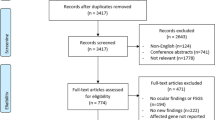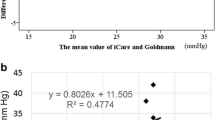Abstract
Distinct eye abnormalities have been described in children with nephrotic syndrome, particularly in diffuse mesangial sclerosis (i.e. Pierson syndrome). The aim of the study was to investigate whether there were any associated ocular anomalies in children with steroid-resistant nephrotic syndrome (SRNS), all of whom had revealed primary focal segmental glomerulosclerosis in biopsy. Thirty-three SRNS patients (16 male, 17 female) with a median age of 10.5 years (range 3–25 years) were enrolled in the study. Twenty steroid-sensitive nephrotic syndrome (SSNS) patients (ten male, ten female) with a median age of 8 years (range 3–15 years) served as controls. All SRNS patients were examined by mutational analysis for mutations in the NPHS2, WT1, and LAMB2 genes. Nine out of 33 SRNS patients (27.2%) showed various eye abnormalities. However, no abnormal ocular findings were detected in any of the SSNS patients. Abnormal eye findings detected in SRNS patients were anisometropic amblyopia (n = 4), Mittendorf’s dots (n = 4), myopic astigmatism (n = 3) and exotropia (n = 1). Macular pigment changes (n = 1), posterior subcapsular opacities (n = 1) and cataract (n = 1) were considered as steroid-induced side effects. In four patients, more than one eye abnormality was found. Mutational analysis for the NPHS2, WT1 and LAMB2 genes revealed disease-causing mutations in 24.2% of patients. Homozygous NPHS2 mutations were detected in five patients (15.1%), all of whom had parental consanguinity. In three patients (9%) from non-consanguineous parents, heterozygous de novo WT1 mutations were detected as disease-causing mutations. No LAMB2 mutation was detected in any patient. While four out of five (80%) patients with homozygous NPHS2 mutations showed at least one abnormal ocular finding (i.e. Mittendorf’s dot or anisometric amblyopia), none of the patients with a WT1 mutation had ocular involvement. In conclusion, ocular involvement may accompany SRNS caused by primary focal segmental glomerulosclerosis (FSGS). Ophthalmologic evaluation at the time of diagnosis might be beneficial to characterize further the spectrum of this possible association.
Similar content being viewed by others
References
International Study of Kidney Disease in Children (1981) Primary nephrotic syndrome in children: Clinical significance of histopathologic variants of minimal change and of diffuse mesangial hypercellularity. Kidney Int 20:765–771
Niaudet P (2004) Steroid-resistant idiopathic nephrotic syndrome in children. In: Avner ED, Harmon WE, Niaudet P (eds) Pediatric nephrology, 5th edn. Lippincott Williams&Wilkins, Philadelphia, pp 557–573
Korbet SM (1998) Primary focal segmental glomerulosclerosis. J Am Soc Nephrol 9:1333–1340
Border WA (1988) Distinguishing minimal-change disease from mesangial disorders. Kidney Int 34:419–434
Kestila M, Lenkkeri U, Mannikko M, Lamerdin J, McCready P, Putaala H, Ruotsalainen V, Morita T, Nissinen M, Herva R, Kashtan CE, Peltonen L, Holmberg C, Olsen A, Tryggvason K (1998) Positionally cloned gene for a novel glomerular protein—nephrin—is mutated in congenital nephrotic syndrome. Mol Cell 1:575–582
Boute N, Gribouval O, Roselli S, Benessy F, Lee H, Fuchshuber A, Dahan K, Gubler MC, Niaudet P, Antignac C (2000) NPHS2, encoding the glomerular protein podocin, is mutated in autosomal recessive steroid-resistant NS. Nat Genet 24:349–354
Kaplan JM, Kim SH, North KN, Rennke H, Correia LA, Tong HQ, Mathis BJ, Rodriguez-Perez JC, Allen PG, Beggs AH, Pollak MR (2000) Mutations in ACTN4, encoding alpha-actinin-4, cause familial focal segmental glomerulosclerosis. Nat Genet 24:251–256
Zenker M, Aigner T, Wendler O, Tralau T, Müntefering H, Fenski R, Pitz S, Schumacher V, Royer-Pokora B, Wühl E, Cochat P, Bouvier R, Kraus C, Mark K, Madlon H, Dötsch J, Rascher W, Maruniak-Chudek I, Lennert T, Neumann LM, Reis A (2004) Human laminin beta2 deficiency causes congenital nephrosis with mesangial sclerosis and distinct eye abnormalities. Hum Mol Genet 13:2625–2632
Winn MP, Conlon PJ, Lynn KL, Farrington MK, Creazzo T, Hawkins AF, Daskalakis N, Kwan SY, Ebersviller S, Burchette JL, Pericak-Vance MA, Howell DN, Vance JM, Rosenberg PB (2005) A mutation in the TRPC6 cation channel causes familial focal segmental glomerulosclerosis. Science 308:1801–1804
Hinkes B, Wiggins RC, Gbadegesin R, Vlangos CN, Seelow D, Nürnberg G, Garg P, Verma R, Chaib H, Hoskins BE, Ashraf S, Becker C, Hennies HC, Goyal M, Wharram BL, Schachter AD, Mudumana S, Drummond I, Kerjaschki D, Waldherr R, Dietrich A, Ozaltin F, Bakkaloglu A, Cleper R, Basel-Vanagaite L, Pohl M, Griebel M, Tsygin AN, Soylu A, Müller D, Sorli CS, Bunney TD, Katan M, Liu J, Attanasio M, O’toole JF, Hasselbacher K, Mucha B, Otto EA, Airik R, Kispert A, Kelley GG, Smrcka AV, Gudermann T, Holzman LB, Nürnberg P, Hildebrandt F (2006) Positional cloning uncovers mutations in PLCE1 responsible for a nephrotic syndrome variant that may be reversible. Nat Genet 38:1397–1405
Fuchshuber A, Gribouval O, Ronner V, Kroiss S, Karle S, Brandis M, Hildebrandt F (2001) Clinical and genetic evaluation of familial steroid-responsive nephrotic syndrome in childhood. J Am Soc Nephrol 12:374–378
Ruf RG, Schultheiss M, Lichtenberger A, Karle SM, Zalewski I, Mucha B, Everding AS, Neuhaus T, Patzer L, Plank C, Haas JP, Ozaltin F, Imm A, Fuchshuber A, Bakkaloglu A, Hildebrandt F, APN Study Group (2004) Prevalence of WT1 mutations in a large cohort of patients with steroid-resistant and steroid-sensitive nephrotic syndrome. Kidney Int 66:564–570
Mucha B, Ozaltin F, Hinkes BG, Hasselbacher K, Ruf RG, Schultheiss M, Hangan D, Hoskins BE, Everding AS, Bogdanovic R, Seeman T, Hoppe B, Hildebrandt F, Members of the APN Study Group (2006) Mutations in the Wilms’ tumor 1 gene cause isolated steroid resistant nephrotic syndrome and occur in exons 8 and 9. Pediatr Res 59:325–331
Habib R (1993) Nephrotic syndrome in the 1st year of life. Pediatr Nephrol 7:347–353
Gubler MC, Heidet L, Antignac C (2004) Inherited glomerular diseases. In: Avner ED, Harmon WE, Niaudet P (eds) Pediatric nephrology, 5th edn. Lippincott Williams&Wilkins, Philadelphia, pp 517–542
Kurli M, Finger PT (2005) The kidney, cancer, and the eye: current concepts. Surv Ophthalmol 50:507–518
Shapiro LR, Duncan PA, Farnsworth PB, Lefkowitz M (1976) Congenital microcephaly, hiatus hernia and nephrotic syndrome: an autosomal recessive syndrome. Birth Defects Orig Arctic Ser 12:275–278
Mildenberger E, Lennert T, Kunze J, Jandeck C, Waldherr R, Versmold H (1998) Diffuse mesangial sclerosis: association with unreported congenital anomalies and placental enlargement. Acta Paediatr 87:1301–1303
Dreyer SD, Zhou G, Baldini A, Winterpacht A, Zabel B, Cole W, Johnson RL, Lee B (1998) Mutations in LMX1B cause abnormal skeletal patterning and renal dysplasia in nail patella syndrome. Nat Genet 19:47–50
Arbetsgemeinschaft für Pädiatrische Nephrologie (1988) Short versus standard prednisone therapy for initial treatment of idiopathic nephrotic syndrome in children. Lancet 1:380–383
International Study of Kidney Disease in Children (1981) The primary nephrotic syndrome in children. Identification of patients with minimal change nephrotic syndrome from initial response to prednisone. J Pediatr 98:561–564
Arbetsgemeinschaft für Pädiatrische Nephrologie (1979) Alternate-day versus intermittent prednisone in frequently relapsing nephrotic syndrome. Lancet 1:401–403
Pierson M, Cordier J, Hervouuet F, Rauber G (1963) An unusual congenital and familial congenital malformative combination involving the eye and kidney. J Genet Hum 12:184–213
Putaala H, Soininen R, Kilpelainen P, Wartiovaara J, Tryggvason K (2001) The murine nephrin gene is specifically expressed in kidney, brain and pancreas: inactivation of the gene leads to massive proteinuria and neonatal death. Hum Mol Genet 10:1–8
Frishberg Y, Feinstein S, Rinat C, Becker-Cohen R, Lerer I, Raas-Rothschild A, Ferber B, Nir A (2006) The heart of children with steroid-resistant nephrotic syndrome: is it all podocin? J Am Soc Nephrol 17:227–231
Amaya L, Taylor D, Russell-Eggitt I, Nischal KK, Lengyel D (2003) The morphology and natural history of childhood cataracts. Surv Ophthalmol 48:125–144
Webber AL, Wood J (2005) Amblyopia: prevalence, natural history, functional effects and treatment. Clin Exp Optom 88:365–375
Hussein MA, Coats DK, Muthialu A, Cohen E, Paysse EA (2004) Risk factors for treatment failure of anisometropic amblyopia. J AAPOS 8:429–434
Huynh SC, Kifley A, Rose KA, Morgan IG, Mitchell P (2007) Astigmatism in 12-year-old Australian children: comparisons with a 6-year-old population. Invest Ophthalmol Vis Sci 48:73–82
Spraul CW, Lang GE, Lang GK (1998) Retinal pigment epithelial changes associated with systemic corticosteroid treatment: report of cases and review of the literature. Ophthalmologica 212:142–148
Ozcakar ZB, Cengiz FB, Cakar N, Uncu N, Kara N, Acar B, Yuksel S, Ekim M, Tekin M, Yalcinkaya F (2006) Analysis of NPHS2 mutations in Turkish steroid-resistant nephrotic syndrome patients. Pediatr Nephrol 21:1093–1096
Ruf RG, Lichtenberger A, Karle SM, Haas JP, Anacleto FE, Schultheiss M, Zalewski I, Imm A, Ruf EM, Mucha B, Bagga A, Neuhaus T, Fuchshuber A, Bakkaloglu A, Hildebrandt F (2004) Patients with mutations in NPHS2 (podocin) do not respond to standard steroid treatment of NS. J Am Soc Nephrol 15:722–732
Caridi G, Bertelli R, Scolari F, Sanna-Cherchi S, Di Duca M, Ghiggeri GM (2003) Podocin mutations in sporadic focal-segmental glomerulosclerosis occurring in adulthood. Kidney Int 64:365
Maruyama K, Iijima K, Ikeda M, Kitamura A, Tsukaguchi H, Yoshiya K, Hoshii S, Wada N, Uemura O, Satomura K, Honda M, Yoshikawa N (2003) NPHS2 mutations in sporadic steroid-resistant nephrotic syndrome in Japanese children. Pediatr Nephrol 18:412–416
Author information
Authors and Affiliations
Corresponding author
Rights and permissions
About this article
Cite this article
Ozaltin, F., Heeringa, S., Poyraz, C.E. et al. Eye involvement in children with primary focal segmental glomerulosclerosis. Pediatr Nephrol 23, 421–427 (2008). https://doi.org/10.1007/s00467-007-0695-8
Received:
Revised:
Accepted:
Published:
Issue Date:
DOI: https://doi.org/10.1007/s00467-007-0695-8




